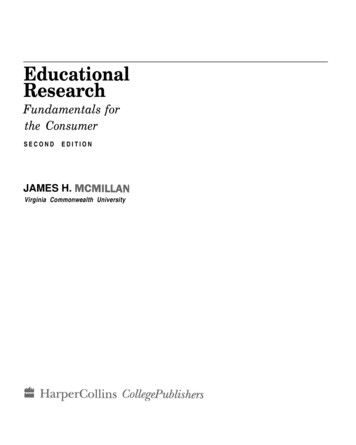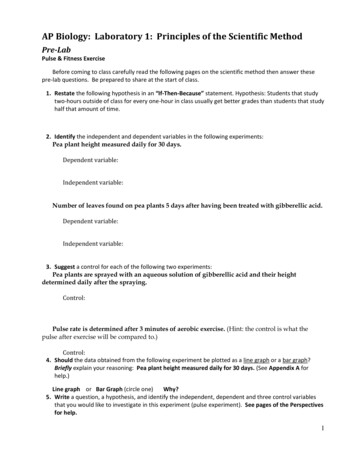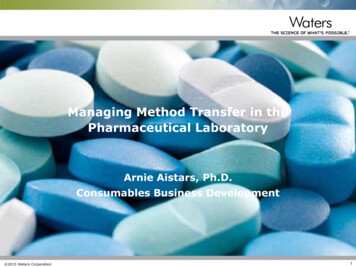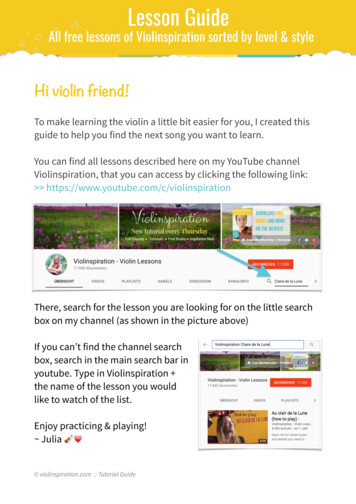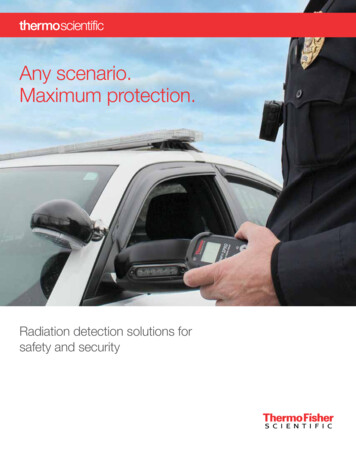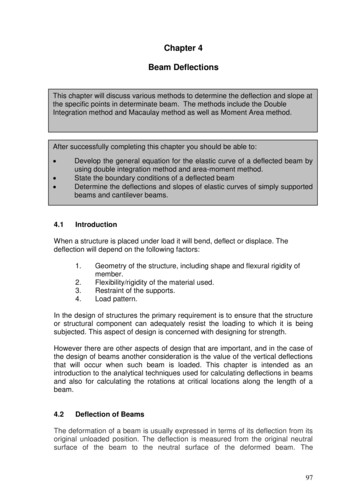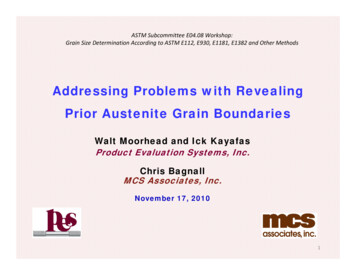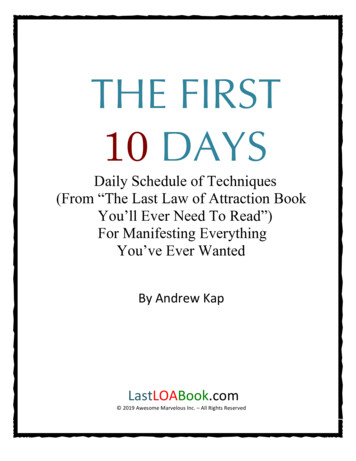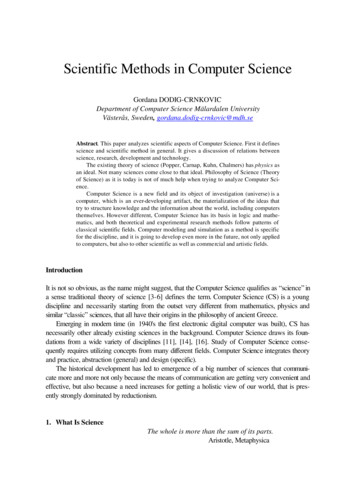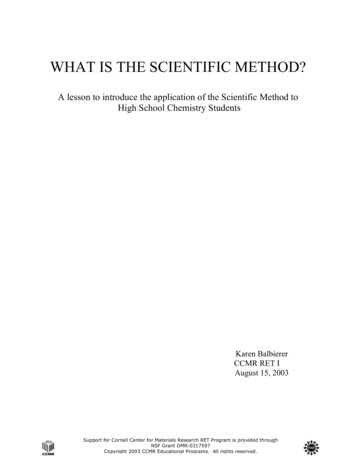
Transcription
WHAT IS THE SCIENTIFIC METHOD?A lesson to introduce the application of the Scientific Method toHigh School Chemistry StudentsKaren BalbiererCCMR RET IAugust 15, 2003Support for Cornell Center for Materials Research RET Program is provided throughNSF Grant DMR-0317597Copyright 2003 CCMR Educational Programs. All rights reserved.
Lesson Plan SummaryLesson Subject: Introduction and application of the Scientific Method.Audience: High School Chemistry Students - Grades 10 through 12Major Skills and Concepts: Know the systematic approach of the Scientific Method Observations Hypothesis Experiment Conclusion – can lead to theory or natural law Apply the Scientific Method to gather knowledge and make conclusions about a mixture Make observations Develop a hypothesis Design a testing method Interpret testing results State a conclusionOther Goals of the lesson: Know some of the historical development of Modern Chemistry Early scientists who used scientific thinking Application of good laboratory practices Handling materials safely and appropriately Obtaining and maintaining equipment appropriately. Lab report Application of write-up format to be used in this course. Creating an appropriate data table and recording observationsEstimated Time for Lesson: 80-85 minute block approximately 25 minutes for set and notes approximately 55-60 minutes for pre-lab discussion and lab activityResources:Chemistry, connections to our changing world, 2nd Ed., 2000. Prentice Hall. Upper Saddle River p2-13.Chemistry concepts and application, 2000. Glencoe/McGraw-Hill. New York. p58-59.Physical Setting/Chemistry Core Curriculum, 2002. The State Education es/cf/SciProjIntewr.htmlwww.hom.xnet.com/ blatura/skep l.htmlSupport for Cornell Center for Materials Research RET Program is provided throughNSF Grant DMR-0317597Copyright 2003 CCMR Educational Programs. All rights reserved.
Unit 1 – Chemistry and YouIntroduction to Scientific Method Lesson #1ChemistryPage 1I. Pre-Instructional Phase1. Standard:NYS Standard 1 - Students will use mathematical analysis, scientific inquiry, and engineeringdesign, as appropriate, to pose questions, seek answers, and develop solutions.NYS Standard 4 - Students will understand and apply scientific concepts, principles, and theoriespertaining to the physical setting and living environment and recognize the historicaldevelopment of ideas in science.2. Lesson Objectives:Given lecture, assignment and lab activity the student will:a.Know and Apply the scientific method as an orderly and systematic approach togathering data with 95% accuracy.b.Know and Apply the steps of the scientific method - making an observation, forming ahypothesis, performing the experiment, interpreting the results, determining laws andtheories with 85% accuracy.c.Know with 90% accuracy, that a variable is the factor being tested in the experiment andthat an experimental control provides a standard for comparison.d.Know with 90% accuracy, that a natural law is a conclusion drawn from observations andexperiments and that a scientific theory provides the explanation for the phenomenon thatis observed and stated as a natural law.3.Specific Content, Concepts and Key Vocabulary of Lesson:Scientific Method (Scientific Process)Making ObservationsHypothesis StatementConclusion StatementVariableExperimental ControlNatural LawTheoryTask Analysis – Prior to this lesson Student need be able to:1. Identify hazards and work safely in a laboratory environment.2. Identify physical and chemical properties of substances.3. Identify physical and chemical changes in substances and materials.4. Instructional Aids and Resources:Textbook – Chemistry, connections to our changing world, 2nd Ed., 2000. Prentice Hall. p2-13.5. Student Modifications:- Students will be given additional “Hints/Reminders” in written form to assist students in“successfully” completing the lab activity assignments as defined by the goals of the lesson.Support for Cornell Center for Materials Research RET Program is provided throughNSF Grant DMR-0317597Copyright 2003 CCMR Educational Programs. All rights reserved.
Unit 1 – Chemistry and YouIntroduction to Scientific Method Lesson #1ChemistryPage 2II. Interactive Phase6. Set/Focusing Event / Implementation:Set/Focusing EventHistory Connection – In the mid 1700’s, many scientists were still trying to explain materials interms of combinations of air, earth, fire and water. One French scientist, Antoine Lavoisier,(1743-1794) worked to change the way chemistry was done. Lavoisier had a habit of makingvery careful measurements in his experiments. One of the things he discovered from theseexperiments was that combustion is the result of a reaction with oxygen. Lavoisier also knewthat oxygen is needed for life processes. He supposed that when a person was working, the lifeprocesses increase and more oxygen would be used. So he set up an experiment to measure theamount of oxygen a person breathed while resting- first on an empty stomach and then aftereating food.QuestionsI want you to each think for a minute to yourself - in which case is more oxygen is used?Raise your hand if you think a person uses more oxygen on an empty stomach?Raise your hand if you think a person uses more oxygen after eating?Why do you think more oxygen is used after eating? (It is needed to supply energy for thedigestive process.)Can we set up a test to determine an answer to this question?In general terms, what things do you think are important to know or measure for our test?Should we use two different people - feed one person and then have the person not eat?How long should we measure the consumption of oxygen - for the whole day?Does it matter if the test subjects are in the same place/room for the experiment?Do these things really matter?BridgeSo we need to set some parameters or limitations for our test. All of these different factors orvariables in our testing environment may have an effect on our experiment. So we want to keepas many variables the same to minimize these differences so that we are only looking at theeffect of what we are testing for – the statement that we are investigating – A person uses moreoxygen when food is present. Well, Lavoisier’s measurements did show that more oxygen isused when food is present. Because of the careful way he set-up and performed his experiment,Lavoisier is now recognized as the first modern chemist.Today, a very systematic, careful way of studying materials is still used by scientists researchinganything from creating new materials to examining ways of improving the use or manufacture ofexisting materials.So if we want to examine different materials, which you will be doing today in lab, then youneed to learn how to apply this systematic process of questioning and testing that scientists useto gather knowledge about materials. If you look at the notes outline, you will see this process isreferred to as the Scientific Method.Support for Cornell Center for Materials Research RET Program is provided throughNSF Grant DMR-0317597Copyright 2003 CCMR Educational Programs. All rights reserved.
Unit 1 – Chemistry and YouIntroduction to Scientific Method Lesson #1ChemistryPage 3Activity 1Lecture/Notes on the Scientific Method – use overhead to go through notes outline with students.1.2.3.4.5.The Scientific MethodThe scientific method is a systematic approach to gather knowledge to answer questions about theworld we live in.Steps of the Scientific Method:ObservationsQuestionHypothesis, which is a tentative answer to the question. A hypothesis must be testable.Experiment, includes recording and analyzing data gathered.Each experiment has a variable, the factor being tested and a control.A control responds in a predictable way to the experiment and is used as a basis or standard forcomparison.Conclusion, may lead to new questions, new hypothesis, or new experiments.After many experiments, scientists may summarize results in a natural law, which is a descriptionof how nature behaves.Scientists may formulate a theory. A theory explains why nature behaves the way described by thenatural law.Theories can predict results of further experiments.A law tells us what happened and a theory tells us why.Use demo for students to practice making observations and developing hypothesis statements.– Reaction between vinegar (with some pH indicator) and baking sodaQuestions - Activity 1What types of observations can we make? (measurement, visual changes, odors )What things can we observe during a reaction?( changes in color temperature, fizzing )Formative CheckWhat are some observations we can make about the reaction of vinegar (with some pHindicator) and baking soda?What hypothesis statement can we make if I double the amount of the vinegar and backing soda?Can we test this hypothesis?BridgeScience is a way of thinking and acting. A process of inquiry and investigation not just a bodyof knowledge. This scientific process, the scientific method, is based on the idea that beginswith observations. Using the guidelines of the scientific method you and a partner will conductan investigation to identify the components of an unknown mixture.Support for Cornell Center for Materials Research RET Program is provided throughNSF Grant DMR-0317597Copyright 2003 CCMR Educational Programs. All rights reserved.
Unit 1 – Chemistry and YouIntroduction to Scientific Method Lesson #1ChemistryPage 4Activity 2Lab Activity – Mystery White Powders LabMaterials:White powders used are baking soda, baking powder, corn starch and cream of tartar.-Make up sets of the 4 white powders using empty plastic film canisters labeled using a letterto identify each set (ie. A1, A2, A3, A4).- Make up a couple of different mixtures of the white powders as the unknowns orMystery Mixtures labeling the unknowns with a number ID to better differentiate the samples.Testing liquids with droppers – water, vinegar, iodineWell platesWood splints for scooping out powders without cross contaminating samplesSmall plastic magnifying glassesQuestions - Activity 2See Lab sheetFormative CheckLab write-up will be handed in and graded based on: How well the student knows and applies the steps of the scientific method:- Appropriate completion of the specified lab write-up format, to include the key scientificmethod components - hypothesis, data/observation, analysis and conclusion. How well the student followed the scientific process and that he or she is supporting theirconclusion with evidence from the observations made and the recorded data.Closure“Ticket out the Door” – What are two of the steps in the scientific method?Extending Activity - Independent Study Assignment:Complete 1-2 Worksheets - Practice Problems and Review and Reinforcement.In Textbook – Read p7-12 and answer questions #1-4 on page 13 and questions 1,3 & 4 on p50.Complete write-up for Mystery White Powders LabIII. Post Instructional Phase7. Evaluation:8. Self ReflectionSupport for Cornell Center for Materials Research RET Program is provided throughNSF Grant DMR-0317597Copyright 2003 CCMR Educational Programs. All rights reserved.
STUDENT NOTESSupport for Cornell Center for Materials Research RET Program is provided throughNSF Grant DMR-0317597Copyright 2003 CCMR Educational Programs. All rights reserved.
Chemistry and YouThe Scientific MethodThe scientific method is a approach to gather knowledge to answerquestions about the world we live in.Steps of the Scientific Method:1.2.3. , which is a tentative to the question.A hypothesis must be .4. , includes recording and analyzing data gathered.Each experiment has a , the factor being tested and a control.A control responds in a predictable way to the experiment and is used as a basis for.5. , may lead to new questions, new hypothesis, or new experiments.After many experiments, scientists may summarize results in a ,which is a description of how nature behaves.Scientists may formulate a . A theory explains why nature behaves the waydescribed by the natural law.Theories can results of further experiments.A law tells us what happened and a theory tells us why.Independent Study Assignment:Complete 1-2 Worksheets - Practice Problems and Review and Reinforcement.In Textbook – Read p7-12 and answerquestions #1-4 on page 13 and questions 1,3 & 4 on p50.Complete write-up for Mystery White Powders LabSupport for Cornell Center for Materials Research RET Program is provided throughNSF Grant DMR-0317597Copyright 2003 CCMR Educational Programs. All rights reserved.
LAB ACTIVITYSupport for Cornell Center for Materials Research RET Program is provided throughNSF Grant DMR-0317597Copyright 2003 CCMR Educational Programs. All rights reserved.
Mystery White PowdersName:Partner:Lab #Date Performed:Date Due:Pre-Lab Assignment:For this investigation you and your partner will be given individual samples of four different whitesolids, three testing liquids (water, acetic acid, iodine) and a mystery mixture which is a combinationof two of the four solids.Using the steps of the scientific method you and your partner will:1. Develop a testing procedure to make observations of the properties of the individual white powdersand of your Mystery Mixture.2. Based on your observations, form a hypothesis statement which answers the question –What two substances are in your Mystery Mixture?3. Test your hypothesis.4. State your conclusion about the contents of your Unknown (Mystery Mixture).Hints and Reminders:You will need to create a data table to record all observations of the samples including the letter ofthe solid samples and the ID number for your Unknown (Mystery Mixture).You should test each of your solid samples individually with each of the liquids and record allobservations on your data table.You should test the unknown sample with the liquids using the same procedure as the individualsample and record all observations on your data table. Record the number of your Unknown.The Unknown contains a combination of two of the four white solids. You only need to identifyunknown in terms of the individual samples using the letter ID. You do not need to determinewhat the white solids actually are. (ie. flour, sugar, table salt etc.)Use the observations you recorded for your white solids to determine which two solids are in yourUnknown sample. Your Analysis section must include the evidence you used to determine whichtwo solids you believe are in the unknown.Write a Hypothesis statement about which two substances are in your Unknown. Then test yourhypothesis by mixing the two substances, testing the mixture with the liquids and comparing theresults to the observations for your Unknown.Support for Cornell Center for Materials Research RET Program is provided throughNSF Grant DMR-0317597Copyright 2003 CCMR Educational Programs. All rights reserved.
Mystery White PowdersName:Partner:Lab #Date Performed:Date Due:Here is an outline to help in preparing your formal lab report for the Mystery White Powders Lab.Heading: Should include the name of the lab activity, your name, your partner’s name, the labnumber, the date performed and the date due. See heading above as an example.Purpose: To identify the substances in the Unknown, using the individual samples as reference.Hypothesis: Write your Hypothesis StatementMaterials:List any equipment and substances used for the experiment including theLetter of White Powder Samples used and ID number for the Unknown Sample MixtureProcedure: Write out the steps you performed in conducting the experiment/investigation.The steps should be written as a set of clear instructions that anyone could follow to repeat yourexperiment. Your procedure should not be a narrative of what you did.Data: You need to include a neat, easy to read data table of all of your observations including theunknown. If you redo your original data table for your formal report, you must also include the rawdata table in your report. You cannot discard your original data.Analysis:List all of the physical changes you observed in this lab. Explain how you know they are physical.List all of the chemical changes you observed in this lab. Explain how you know they are chemical.Explain how you developed your Hypothesis Statement – How did you figure out what the twosubstances are - What is your evidence?Conclusion:Did you prove or disprove your original Hypothesis?State which two of the four solids are in your unknown?Discuss any problems you encountered.Evaluate your procedure and describe what you would do differently if you were to repeat theexperiment.Support for Cornell Center for Materials Research RET Program is provided throughNSF Grant DMR-0317597Copyright 2003 CCMR Educational Programs. All rights reserved.
Mystery Mixtures labeling the unknowns with a number ID to better differentiate the samples. Testing liquids with droppers – water, vinegar, iodine Well plates Wood splints for scooping out powders without cross contaminating samples Small plastic magnifying gla

